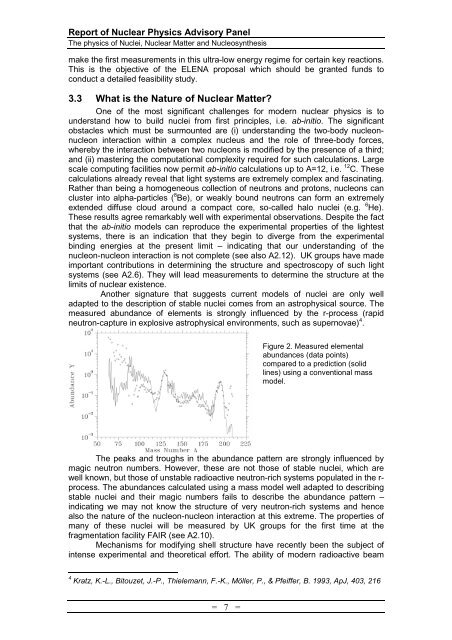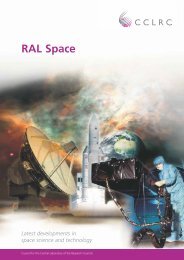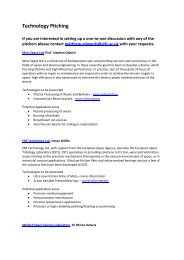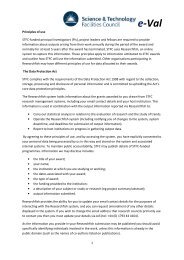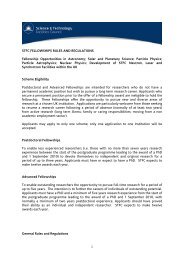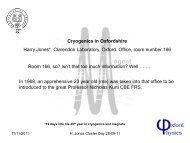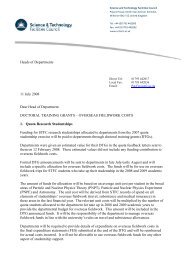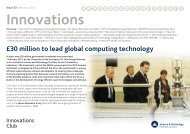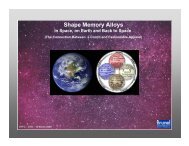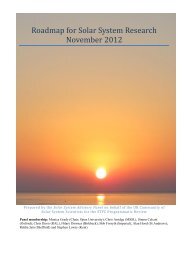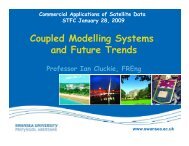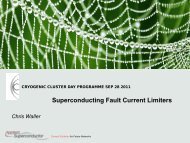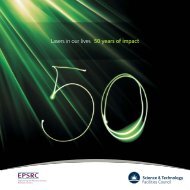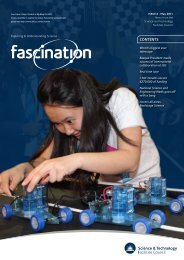Nuclear Physics Advisory Panel (NPAP) report (PDF-3.8 MB) - STFC
Nuclear Physics Advisory Panel (NPAP) report (PDF-3.8 MB) - STFC
Nuclear Physics Advisory Panel (NPAP) report (PDF-3.8 MB) - STFC
You also want an ePaper? Increase the reach of your titles
YUMPU automatically turns print PDFs into web optimized ePapers that Google loves.
Report of <strong>Nuclear</strong> <strong>Physics</strong> <strong>Advisory</strong> <strong>Panel</strong><br />
The physics of Nuclei, <strong>Nuclear</strong> Matter and Nucleosynthesis<br />
make the first measurements in this ultra-low energy regime for certain key reactions.<br />
This is the objective of the ELENA proposal which should be granted funds to<br />
conduct a detailed feasibility study.<br />
3.3 What is the Nature of <strong>Nuclear</strong> Matter?<br />
One of the most significant challenges for modern nuclear physics is to<br />
understand how to build nuclei from first principles, i.e. ab-initio. The significant<br />
obstacles which must be surmounted are (i) understanding the two-body nucleonnucleon<br />
interaction within a complex nucleus and the role of three-body forces,<br />
whereby the interaction between two nucleons is modified by the presence of a third;<br />
and (ii) mastering the computational complexity required for such calculations. Large<br />
scale computing facilities now permit ab-initio calculations up to A=12, i.e. 12 C. These<br />
calculations already reveal that light systems are extremely complex and fascinating.<br />
Rather than being a homogeneous collection of neutrons and protons, nucleons can<br />
cluster into alpha-particles ( 8 Be), or weakly bound neutrons can form an extremely<br />
extended diffuse cloud around a compact core, so-called halo nuclei (e.g. 6 He).<br />
These results agree remarkably well with experimental observations. Despite the fact<br />
that the ab-initio models can reproduce the experimental properties of the lightest<br />
systems, there is an indication that they begin to diverge from the experimental<br />
binding energies at the present limit – indicating that our understanding of the<br />
nucleon-nucleon interaction is not complete (see also A2.12). UK groups have made<br />
important contributions in determining the structure and spectroscopy of such light<br />
systems (see A2.6). They will lead measurements to determine the structure at the<br />
limits of nuclear existence.<br />
Another signature that suggests current models of nuclei are only well<br />
adapted to the description of stable nuclei comes from an astrophysical source. The<br />
measured abundance of elements is strongly influenced by the r-process (rapid<br />
neutron-capture in explosive astrophysical environments, such as supernovae) 4 .<br />
Figure 2. Measured elemental<br />
abundances (data points)<br />
compared to a prediction (solid<br />
lines) using a conventional mass<br />
model.<br />
The peaks and troughs in the abundance pattern are strongly influenced by<br />
magic neutron numbers. However, these are not those of stable nuclei, which are<br />
well known, but those of unstable radioactive neutron-rich systems populated in the r-<br />
process. The abundances calculated using a mass model well adapted to describing<br />
stable nuclei and their magic numbers fails to describe the abundance pattern –<br />
indicating we may not know the structure of very neutron-rich systems and hence<br />
also the nature of the nucleon-nucleon interaction at this extreme. The properties of<br />
many of these nuclei will be measured by UK groups for the first time at the<br />
fragmentation facility FAIR (see A2.10).<br />
Mechanisms for modifying shell structure have recently been the subject of<br />
intense experimental and theoretical effort. The ability of modern radioactive beam<br />
4 Kratz, K.-L., Bitouzet, J.-P., Thielemann, F.-K., Möller, P., & Pfeiffer, B. 1993, ApJ, 403, 216<br />
= 7 =


